Taro root is not as common as other known root vegetables but is versatile. If you’ve ever had taro bubble tea, you have a hint about this vegetable. In this article, I’ll discuss the taste of taro in different recipes, the health benefits, and how to use it.
Some people say taro tastes like potato, and others say it is ube. If you have never tasted taro in anything, dive in with all your senses ready. Get ready to expand your palate for one more flavor.
What is taro?
Taro (Colocasia esculanta) is a root vegetable from the Araceae family. It is native to Africa and Southeast Asia with Nigeria being the World’s largest producer of taro. The country produces over 3 million metric tons every year.
In Nigeria, taro is known as cocoyam. This vegetable is now cultivated in other countries like South America, India, China, Japan, Jamaica, Cuba, and Hawaii. And it bears different names in these parts of the world.
When you hear about taro, it is the yam-like vegetable that is being referred to. It could be white, cream, or light purple inside with brown skin. Taro is a staple in many cuisines. You can have it boiled, fried, roasted, mashed, steamed, or baked.
Taro roots can be dried and ground into flour to be used as an alternative to wheat and other gluten flours. It is also healthy and vegan-friendly.
What does taro root taste like?
Taro is sweet, nutty, and starchy. The mild sweet taste is more pronounced than the nutty and vanilla-like tastes. Generally, taro easily absorbs flavors, which makes it taste differently in different recipes.
What does taro taste like in desserts?
The sweet, nutty, and vanilla-like tastes of taro are more pronounced in desserts like taro ice cream, taro sago, taro with coconut milk, taro frappe, taro pudding, taro smoothie, and taro mochi.
These tastes are complimented by the smooth, creamy, velvety, and mouth-melting textures of these desserts.
What does taro taste like in soups?
Taro lends soups its starchy texture. It makes soups taste creamy or starchy and nutty. Also, taro powder is added to soups as a thickening agent.
What does taro taste like in stir-fries?
Taro tastes starchy and nutty in stir-fry recipes. It has a crispy, sweet, and salty exterior with a soft interior. Taro has the same flavor profile when you pan-fry or deep-fry it to make fritters or chips.
What does taro taste like when you bake or roast it?
Roasting or baking taro gives it a crispy exterior and a soft, starchy interior. It tastes sweet and salty. In some recipes, rotated taro may taste dry and chewy.
What does fermented taro taste like?
Poi is a creamy Hawaiian condiment made by boiling, mashing, and fermenting taro roots. It has a sweet and savory taste that perfectly complements savory dishes.
What does taro milk tea taste like?
Taro milk tea, taro bubble tea, or taro boba are different names for a popular sweet purple tea made with ground taro tea, milk, tapioca pearls, tea leaves, and sugar (optional).
Taro milk tea is thick and creamy. It tastes sweet and nutty with a light vanilla finish. Some people compare the taste with cereal milk, cookies, and buttered popcorn.
However, how you serve your tea, the type of milk, and tea leaves can also influence the taste. Some tastes may be more pronounced than others. Overall, it retains its creamy, sweet, and nutty flavor profile.
Why does taro taste fishy?
Taro roots may taste fishy or meaty when you steam or boil them. Also, because these roots easily absorb flavors, they can take on the taste of other ingredients in the recipe.
Health benefits of eating taro
Taro offers a plethora of nutritional benefits. It is a rich source of carbohydrates and dietary fiber. It is also high in vitamins B6, C & E, alongside other minerals, such as potassium and magnesium.
Eating taro is good for digestive health because of its high fiber content. The fiber content is good for people trying to lose weight. It keeps them feeling full for longer, thereby controlling their appetite and reducing hunger pangs. It also helps to decrease calorie content.
Taro has a low glycemic index, which makes it a perfect choice for people with diabetes. Unlike roots like sweet potato, eating taro will not spike blood sugar levels.
These roots also contain resistant starch alongside fiber, which is beneficial for gut health. This indigestible starch and fibers promote the growth of good bacteria and keep the epithelial cells strong and healthy.
Additionally, the vitamins and minerals help to boost immunity and bone strength.
What can you make with taro?
1. Boiled taro
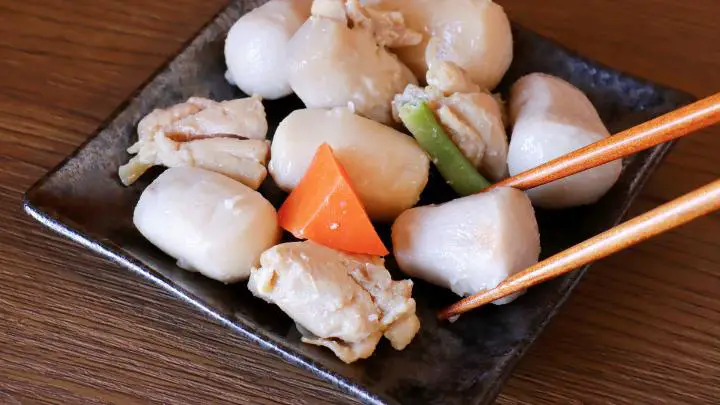
The simplest way to eat taro is to boil and serve with butter, a dipping sauce, or rice.
2. Taro bread

Taro bread is a healthy and gluten-free alternative to wheat bread. It is also tasty with its unique taste.
This recipe uses mashed taro root, flour, yeast, sugar, salt, and butter or margarine. Cut your dough into any shape and size of your choice and bake.
If you do not mind the taro flavor, you can eat your bread with taro soup or any spread of your choice.
3. Taro sago

Taro sago soup is a combination of taro and tapioca. It is a rich, creamy, and hearty soup with chewy tapioca pearls floating in it. You should give it a try.
4. Taro stir-fry
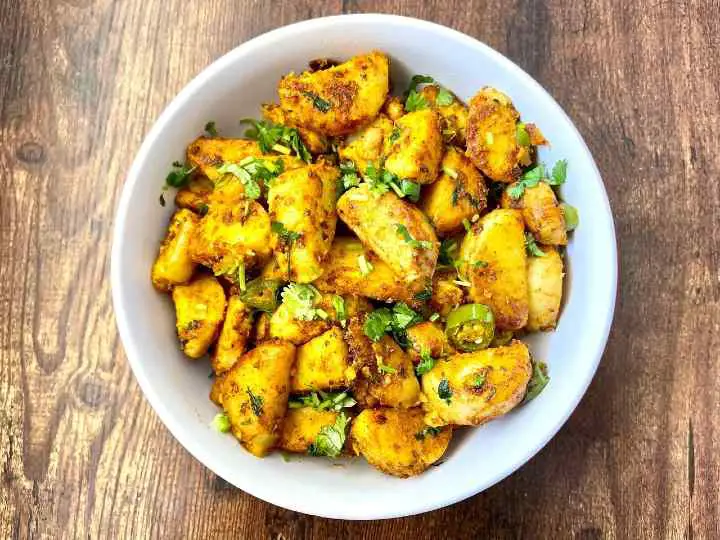
To make taro stir-fry, heat olive oil and cumin in a cast iron skillet. Fry on medium heat until it is golden brown, and add taro cubes. Cook on each side until it is soft.
Afterward, add salt, chili powder, and coriander powder. Turn off the heat when you see the taro cubes almost golden brown. Garnish with cilantro and serve. You can roll taro stir-fry in roti or serve with rice.
5. Taro soup
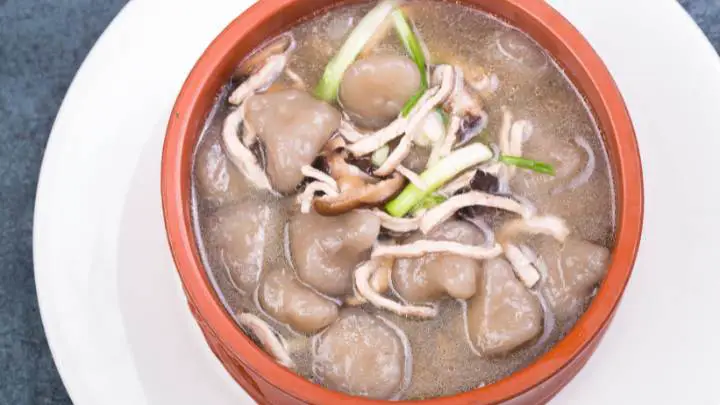
Taro soup is hearty and perfect for a side or main dish (with bread). It is also comforting on cold nights. To make this soup, simmer taro cubes in a rich broth with herbs until it is filled with the flavor of the herbs.
6. Taro stew
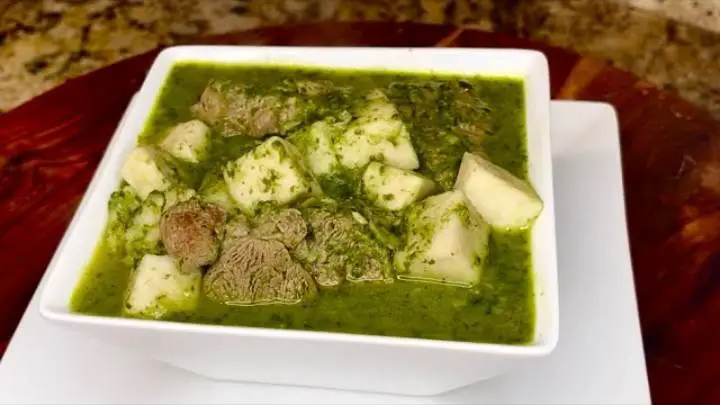
Looking for a different stew to serve with rice? Try taro stew. It is delicious and packs a lot of nutritional benefits. Make a broth with garlic cilantro green sauce. Add taro cubes to the broth and simmer until all the flavors fill the stew.
7. Taro bubble tea

You can get taro bubble tea at bubble tea shops or you can make it at home. It is delicious and easy to make. All you need to make this tea are taro cubes or powder, tea leaves, milk, boba pearls, and sugar (if you like).
Taro powder is instant and easier to make. If you are using taro roots, boil and blend them into a smooth paste using a food processor. Add the sugar to the smooth paste. Boil the boba with sugar as you blend the taro cubes.
Afterward, brew the tea and add milk. Combine all ingredients and serve hot or cold.
8. Chips
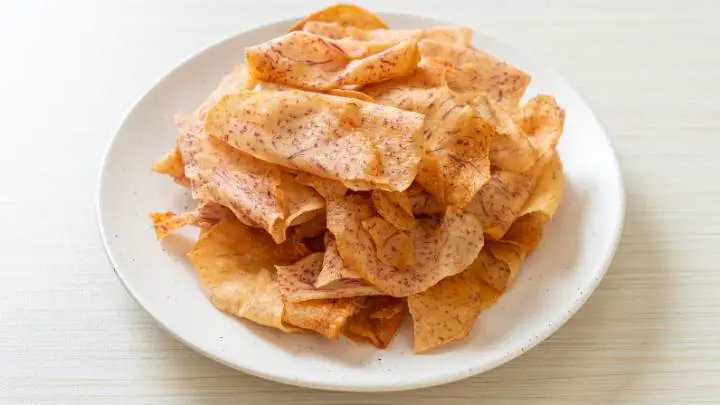
This is probably the easiest thing to make with taro. Coat thin slices of taro with olive oil and bake until they are crispy. After baking, sprinkle sea salt over the hot chips and serve. Perfect for a family snack!
9. Taro fritters
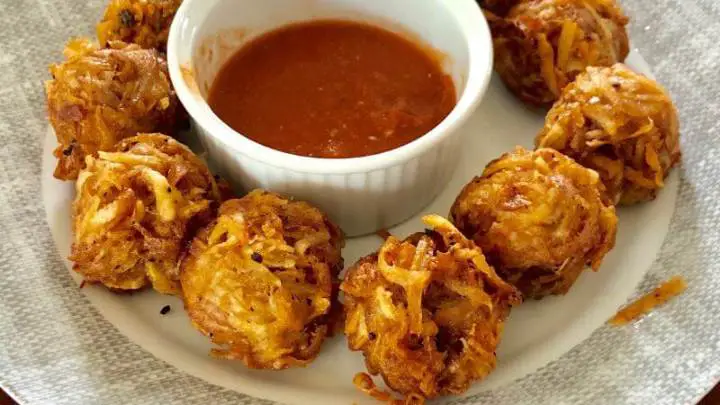
These pan-fried crispy taro fritters are made with taro roots, flour, garlic, carrots, and green onions. They are delicious and highly indulging. Serve with your favorite sauce as an appetizer, midday snack, or a side.
10. Smoothie

Taro smoothie is a healthy vegan alternative to high-sugar smoothies. Blend mashed taro with coconut milk, sugar, water, and ice cubes. Then, serve.
11. Taro dumplings
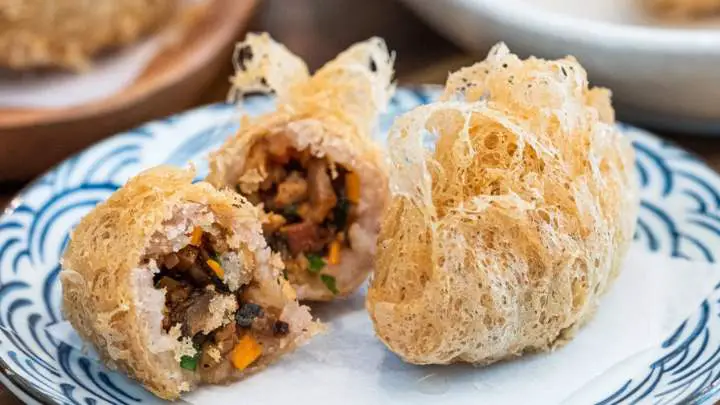
Taro dumplings are a type of dim sum served in Chinese cuisine. The dough is made with mashed taro and filled with pork shoulder, shrimp, shiitake mushrooms, oyster sauce, soy sauce, sugar, salt, pepper, and an assortment of veggies.
You can eat this in Chinese restaurants or make it at home.
12. Taro rice

Taro rice uses Jasmine rice, taro root cubes, shiitake mushrooms, carrots, Chinese sausage, dried shrimp, soy sauce, oyster sauce, and many other ingredients to work Chinese magic. It is hearty with a complex flavor from several ingredients.
13. Pancakes

You can also make pancakes with taro root. Shred taro roots and make a batter with it. Pan-fry and top with sour cream, sriracha sauce, green onions, and smoked salmon. You can serve as an appetizer at a garden party.
14. Ice cream

Taro ice cream is made with cooked taro cubes, coconut milk, and sugar. Blend all three in a food processor and work the paste into ice cream in an ice cream maker. You can play around with your recipe with different flavors and toppings.
15. Taro mochi
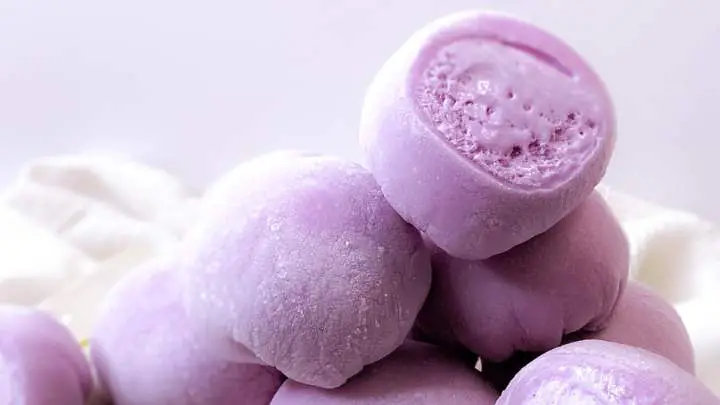
Taro mochi is a great dessert made with taro paste. The mochi dough is made with taro powder, milk, flour, and icing sugar.
The dough is filled with taro paste and chilled in the refrigerator. It’s a perfect idea for parties and Sunday afternoon indulgence.
16. Taro cake
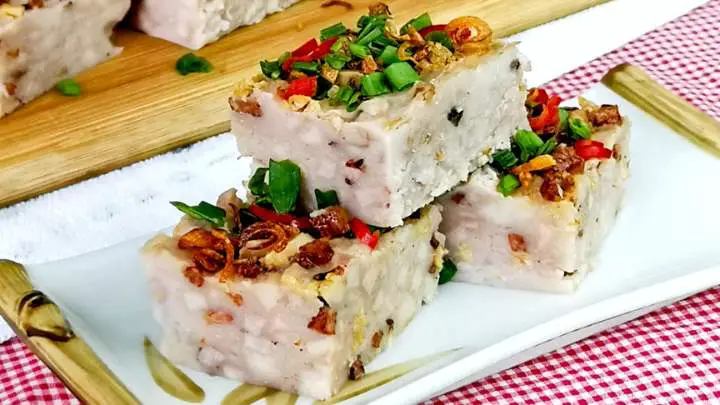
You can make Asian-style steamed taro cake or a spongy chiffon 2-layer taro coconut cake with taro paste and whipped coconut cream filling.
The Asian steamed cake is made from a batter of rice flour, taro, Chinese sausage, Chinese cured pork, dried scallops, dried shrimp, shallots, and radish.
17. Salad
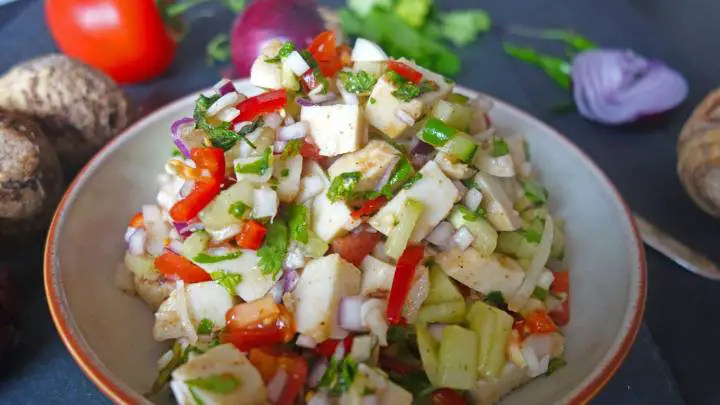
Another exciting recipe to try out with taro is taro root salad. Add boiled taro cubes, chopped greens, and veggies into a bowl. Drizzle olive oil over it and serve.
18. Taro latte

If you are looking to control your caffeine intake, this might just be the coffee for you. Taro latte is caffeine-free and easy to brew. This latte is a mixture of taro, coconut powder creamer, honey, and water.
19. Taro flour
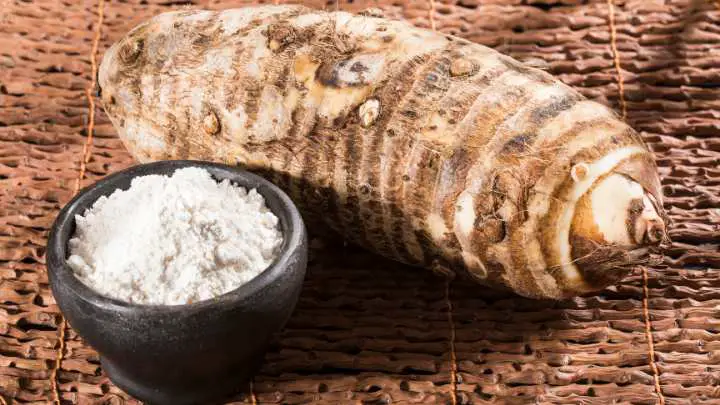
Taro flour is an edible flour made from crushed dry taro roots. It is a healthy alternative to gluten flours and is used in many recipes. Common uses of taro roots include making poi, thickening agents for soups, stews & sauces, baking, etc.
FAQs
Is taro yam?
Taro is not yam or any of its species. They look a lot like purple yams (ube), but they are not. Taro is native to Southeast Asia, while ube is native to the Philippines. Also, taro has white or light purple roots, and ube has purple roots.
Does taro taste like ube?
Ube is sweeter than taro because it has more natural sugars. Ube has a stronger vanilla taste than taro.
Taro tastes more raw and starchy, which makes it a better alternative to potatoes. On the other hand, ube is used in sweet dishes and desserts. They have a nutty flavor in similarity.
Can you eat raw taro?
Raw taro is toxic. It contains calcium oxalate, a poisonous compound that can damage the kidneys when consumed in excess. Eating raw taro can also make your mouth and throat itchy.
What does taro smell like?
Whether you steam, boil, fry, roast, or bake taro, it maintains its original sweet, nutty, and buttery scent. It could also take on other aromas present in the recipe.
Conclusion
If you’ve tasted taro milk tea but couldn’t put a name to the taste of taro, I hope you can now. And if you have never had it, you can look forward to the sweet, nutty, vanilla-like flavor.
Taro root does not only have an impressive flavor profile, but it is also highly nutritious. It should be a part of your diet, especially if you are eating gluten-free or vegan.
Explore the flavor profile of this root vegetable in various soups and stir-fries recipes. Enjoy!
Here’s something else for your palate. Explore the flavor profile of cactus and a list of ways to eat it.
Thanks for reading.
